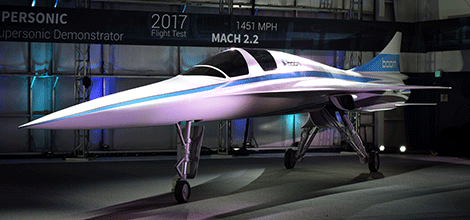
Boom is looking to reintroduce commercial supersonic flight, partnering with Stratasys for the manufacture of its concept XB-1 aircraft
Fast off the back of its McLaren F1 partnership, Stratasys has signed a deal with Boom Supersonic to leverage its 3D printing technology in the design, development and manufacture of its supersonic planes.
Boom’s supersonic airliner will fly 2.6 times faster than any other aircraft on the market today, accelerating to 1,451 miles per hour, with a design 30 per cent more efficient than concorde, as it looks to shift commercial airline toward routine supersonic travel.
Its three-year deal with Stratasys will see them implement Stratasys FDM-based Fortus 450mc and F370 3D Printers for tooling and on-demand parts as it countdown to the first flight of its XB-1 supersonic demonstrator aircraft – the “Baby Boom”.
“Supersonic flight has existed for over 50 years, but the technology hasn’t existed to make it affordable for routine commercial travel,” said Boom CEO and founder Blake Scholl at an announcement during the build up to Paris Air Show.
“Today’s significant advances in aerodynamics, engine design, additive manufacturing, and carbon fiber composite materials are transforming the industry at all levels. Additive manufacturing helps accelerate development of a new generation of aircraft.”
The agreement will allow Boom to leverage Stratasys’ 3D printing solutions and materials, as well as its expert services at its headquarters in Denver, Colorado.
https://youtube.com/watch?v=hGbcnhzOWWU%3Frel%3D0%26controls%3D0
Newly announced, the Fortus 900mc Aircraft Interiors Certification Solution adds a new dimension to Stratasys’ 3D printing solutions for aerospace production.
Based on its Fortus 900mc Production 3D Printer printing Ultem 9085 resin, the system is undergoing FAA and EASA certification requirements at the National Center for Advanced Materials Performance (NCAMP), part of the National Institute of Aviation Research (NIAR) at Wichita State University, USA.






